The Uttara Kannada Experience
The Uttara Kannada Experience
Karnataka’s famed coastline runs through the districts of Uttara Kannada and Dakshina Kannada. The landscape throughout rarely differs – swaying coconut and areca nut palms, beautiful beaches and the vast expanse of the blue seas, framed by the thick green vegetation of the Western Ghats. And soon you might want to call this place home!
With no definite itinerary but just to take it as it comes, we started our journey from Bangalore at around 10.00 pm. As we woke from our sleep, our eyes soaked up the beautiful sight of what is known as the Jog Falls. This time of the year, there was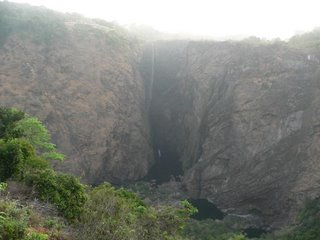
not much water, just a thin white line. Nevertheless, we did appreciate the striking topography of the place and one understands why Jog Falls enjoys the reputation of being the highest waterfall in India. Steps, which help people to appreciate the falls from different angles have been put up here. As, Raghu went to explore more, he heard the sound of a small stream nearby from where a whistling sound could be heard. This was at about 7 in the morning. It could, however, not be attributed to a happy, merry person but was the handiwork of the whistling thrush, which remained hidden but for its whistling with variations in pitch and cadence. Also dove calls could be heard. Promptly, he recorded the sounds on his cell phone.
Jog was just meant to be a whistle stop on our way. And soon after a refreshing cup of tea (or coffee as the case may be), we proceeded to Honnavar, a small coastal town in Uttara Kannada.
On the way, we came across a sign post which declared `Sharavathi River Valley’. A platform constructed next to it provided a good view. We could see the river, snaking its way between hills, thick and green with vegetation, The river did not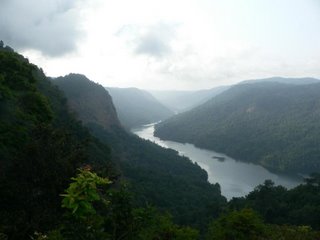
appear to be flowing briskly but on closer inspection (with binoculars), we could see that it was flowing, albeit slowly. Orioles and small, yellow coloured birds flew merrily all around the place with langurs jumping from one tree to another. Also, large raptors could be seen soaring above the valley. A sumptuous treat for a bird/nature lover.
A good bath to wash away the rigours of an overnight journey and after a good sized breakfast we were off, this time to explore a place called Yana, about 45 kilometers away from Honnavar.
Yana
An exotic sounding name and an equally exotic experience to match. As we came closer and closer to our destination, our vehicle had to navigate through a rather thick forest with very bad roads and steep curves on the way. We enjoyed the beauty of the forest and the lovely trees but not so our driver who muttered colourful curses each time he had to navigate a rather steep curve.
As we kept on going, it looked like as if we had come to the end of the world. Just one or two rickety shops on the way and a few solitary houses. Some of them had a kennel of sorts for the dogs. This was to protect them from the leopards which found them easy prey. Finally, we came to a point where all vehicles had to stop for the journey now would be done on foot. A trek of about one and a half kilometers would take us to the top where the real attraction lay.
And so it began. We trudged along slowly. The path got steeper and steeper. On one side was a thick forest cover and on the other side a little stream gave us company. Although it was very hot in these parts, here it seemed very cool. The place was also rife with dragonflies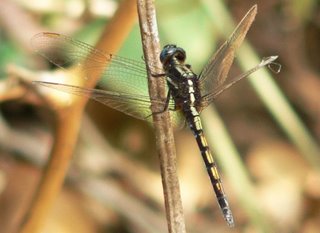
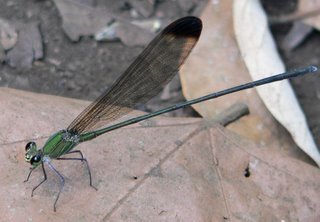
and butterflies, adding a dash of colour as they darted around. My husband felt his trip was made when he was able to photograph the monitor lizard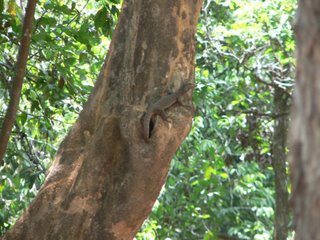
which in appearance looks like a miniature version of the dinosaur. Apparently, the locals here have been able to sight the deadly reptile – King Cobra. All along the way were little waterfalls which cooled anyone who chose to take a dip.
The path was now distinctly uphill and we had to frequently stop on the way to catch our breath. There were steps now and at the last turning there they were – the wonders of Yana.
A huge lofty black structure many meters tall, with jagged edges jutted out into the sky looking arrogant and stately simultaneously. Man might never be able to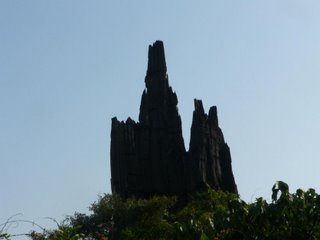
replicate this creation. It was a jaw dropping sight to be sure. I almost felt I was in Inca country. Inside this structure, there were hollows where temples could be found.
A second structure which looked very much like the first one awaited us. Similarly striking, there was a temple at the base dedicated to Lord Shiva. The temple priest told us a rather fetching tale about the history of the place. The only bit I was enlightened about was as to how the place got its name. The place was formerly known as `Sahyadripura’. In the times of the British, people who trekked here, when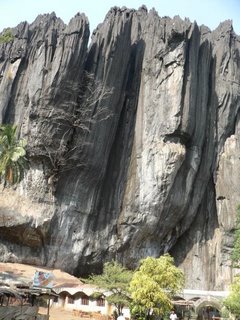
questioned by their colonial masters said they were going on a `yana’, meaning pilgrimage in Kannada. The British thought that perhaps the name of the place was Yana and hence it came to be known as Yana. Trust the British to twist anything to their convenience! A pradakshina around the temple takes one through caves and as you complete encircling the temple, you feel like patting yourself for the accomplishment.
Yana and hence it came to be known as Yana. Trust the British to twist anything to their convenience! A pradakshina around the temple takes one through caves and as you complete encircling the temple, you feel like patting yourself for the accomplishment.
Viewed from different angles, the structures present a different look altogether. Scientists and geologists have been at pain to explain how these rock-like formations took place. Some say it was due to a volcanic eruption. Whatever the case might be, the underlying truth is that the twin structures must be the handiwork of a rather playful and teasing God.
As we made our way back, we were able to catch sight of two Malabar grey hornbills. We tried to take a picture but they disappeared into the forest. Thus, having exercised every muscle in our body, we returned to Honnavar, weary with exhaustion, but basking in the glow of achievement.
The next day, we set out to see the beach at Dhareshwar. Dhareshwar was close to Kumta, another small coastal town. From Kumta, as we travelled on the national highway (connects to Udupi, Mangalore and Kerala), a small village called Dhareshwar appeared. Here, just off the main road, was a diversion for about a kilometer or so and this road lead us to the Dhareshwar beach. One would never guess how close the beach was from the highway. It was like our own private paradise. Except for a few local children playing cricket, there was hardly anybody on the beach. Miles and miles of white sand and the blue sea, one side being cordoned off by a big mountain. What beauty, what peace, what tranquility. After that we were off to a little village called Haldipur, about 3 kilometers from Dhareshwar. Be still I told my wildly beating heart as we reached Haldipur for Haldipur happened to be my Dad’s native place. The river (actually backwaters of the sea), the Konkan Railway line which cut right across the village, the coconut/areca nut groves, the quaint houses was all like a walk down memory lane. Ah! How nostalgic one gets.
After a good lunch hosted by relatives, we set out for Gokarna, an hour and a half’s drive from Haldipur.
Gokarna
The sea side town of Gokarna is a big draw with Indians and foreigners alike. For the former, Gokarna represents a holy place with the added allure of a beach and the sea. For the latter, it is the pristine beauty of the beaches.
Roughly an hour’s drive from Haldipur and we were in holy country, Gokarna. We decided to first check out the Om Beach
at Gokarna, which is a few kilometers away from the main shrine. As we drove on the road leading to the beach, we caught a glimpse of the beauty that unfolded before us – the blue sea and the Om Beach,
so called as it resembled the shape of the Hindu mystical symbol `Om’. Sheer genius to bring home this observation and a case of divine providence perhaps, being located in Gokarna – an ancient place of Hindu worship.
Om Beach was all seclusion. It was as if this portion was cut off and put where it currently is. From a good height above, we got to see the entire beach spread out before us. To get to the beach, we needed to navigate a few steep steps. At this point, high up, we were treated to a bird’s eye view of the beach. There were not too many people on the beach. Just about this place, on a tree branch which stood out, were a pair of red vented bulbuls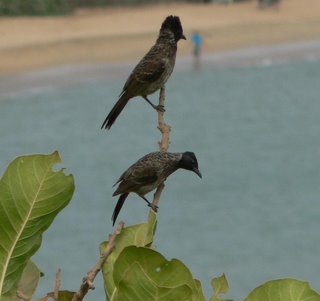
which we managed to shoot. Just then, a pair of black naped orioles flew past us which we could only gape at.
In recent times, Om Beach has acquired fame as the favourite haunt of foreigners. They were all there, scattered all along the beach in small groups, some eating and drinking in the shanties that had cropped up on the beach.
The waters looked inviting and tentatively at first and gaining confidence with every little drenching, we waded out into the sea. We frolicked about, shrieking, when caught by a rather large wave. What is it about the sea that turns well-mannered adults into shouting, playful, boisterous children? Ah! One needs but to experience it.
After an hour or so in the water, we took a walk along the beach. As we walked, we noticed a few boats carrying people and it looked like they were enjoying a ride on the sea. We decided to try this one out. After the mandatory haggling, the boatman after having seated us in his boat took us for a lovely ride. Far, far away from the beach the boat went into the blue swirling waters of the sea. We noticed an island in the distance and a few people waved to us, which we heartily reciprocated. It was a novel experience, out in the sea on a rather rickety boat with no life jackets! The cool breeze soothed our fevered brow and soon our ride came to an end. Could not sight any sea birds in this vicinity.
After that, we left behind the delights of Om Beach and as we made our way to the main shrine at Gokarna, the sun seemed to bid us good-bye as it began its journey westward. From a big red fireball, it seemed to diminish in size until it was a red dot and it all but disappeared from our view altogether, leaving behind the sky awash with a multitude of colours.
After this ethereal experience (no matter how may times you watch it), our next stop was at the beach which is just a stone’s throw from the main shrine at Gokarna.. The scene that was presented to us here was very unlike the Om Beach. Here, there was a sea of humanity; some on the beach, sitting and chatting and some others playing about in the sea. The entire atmosphere resembled that of a fair what with makeshift shops dotting the beach, hawking their wares from beverages, fried snacks and other sundry items. A few of our party proceeded to gambol about in the sea. Some of us were rather hungry (the air makes it so) and we went to one of the shops and had our fill.
After that it was time for us to pay our respects to the presiding deity of Gokarna, Lord Shiva. Gokarna is an important place for the followers of Shaivism. Mythology tells us that when Ravana could not fulfill his promise of not keeping the linga (which Lord Shiva gave him as a boon) on the ground, thanks to the intervention of a rather mischievous Ganesha, he flung the linga in anger and one piece is supposed to have landed in Gokarna. Hence, the religious importance attached to the place.
By now, it was almost 9 p.m. and the business of eating dinner presented itself. We went to one hotel recommended by most of the town folk but to our disappointment, they had just closed their dinner service. Finally, just a few steps ahead, there was a hotel and thankfully their service was open. There was a rooftop restaurant and we huffed and puffed our way to the top (the stairs were rather steep). The table next to ours was occupied by two foreigners, both young girls. My father-in-law marveled at the freedom their parents gave them to be able to travel to a distant land and that too unescorted.
We had already decided to spend the night in Gokarna. We scouted around for accommodation and as we were doing so a priest volunteered to show us a decent place. It was actually a newly constructed house owned by locals and the rooms on the first floor doubled as a hotel room. Quite an enterprise! So, we spent the night there and the very next morning headed out to the beach near the main shrine. A few meters before the beach, we caught sight of the stork billed kingfisher which then made itself scarce among the coconut palms.
At the beach, a small crowd had already collected there. The waves here were quite rough and huge. A few young men seemed quite at ease, riding the waves. Encountering a rather huge wave, I lost my balance and came up all sputtering with a good deal of sodium chloride in my mouth. After that out of a healthy respect for the sea, I stayed a little distance away, enjoying myself nevertheless. After this, we breakfasted at a popular hotel and then said our byes to Gokarna but not before picking up a few knickknacks. Collecting souvenirs from places that I visit has almost become a ritual with me.
Our next halt was a very brief one at Karwar. The naval base `Seabird’ is located here and we could see a huge ship that was docked there. As it falls under the Defence jurisdiction, no one is allowed admittance. We managed to catch sight of it at a certain bend in the road. We spent a few minutes on the beach named after the Nobel laureate, Rabindranath Tagore. In one of his memoirs, he has described the Karwar beach in glowing terms.
We had enjoyed our bit of the sun, sand and the sea and it was now time to wrap it all up with a new kind of experience where silence is golden, punctuated only by bird/animal calls and insect sounds. Yes, Anshi National Park, situated on the Karwar-Dandeli road was to be our next stop.
Kadra View Point

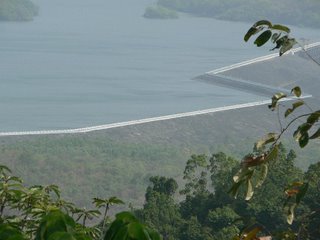
Anshi National Park
After a quick lunch at Karwar, we were on our way. For nature lovers, a sure treat was in store – lovely trees on both sides of the road and dense at that. The magic never stopped and my eyes took in all this beauty hungrily and thirsting for more. And finally we were in the lap of nature itself as we entered the gates of the Anshi National Park. The park is home to many birds and animals. Elephants are not found here but the park is home to the most beautiful, very shy – black panther.
We refreshed ourselves with a good cup of tea/coffee and then decided to go for a stroll in the forest. Leaving our vehicle at some distance in the forest, we decided to explore on foot. One, two, three, we walked in single file on the narrow forest path and on both sides the forest cover was thick. Quite unlike our experience at other wild life parks. As it was nearing dusk, we looked about warily, holding sticks in our hand should we come across a carnivore or any other animal that the forest was blessed with. Soon, almost by magic, we came to a clearing and here the evening light was still present.
We decided to go back as it would be dark soon and god knows what dangers lurked here! Raghu, my butterfly/dragonfly loving husband, was busy photographing a couple of them. He later identified one of them as the adult ant-lion.
We implored him to hurry up. Then we marched back and the sight of our vehicle was very reassuring.
Back then within the camp and we relaxed in the huge sitting/dining area on rattan chairs. All around it was dark save for this area and the kitchen. Here, solitude gets a new meaning. We decided to explore the area just outside the gate of the park. As we strolled along the tarred road, the moon was missing and hence it was dark which made us feel very eerie. A perfect setting for an Edgar Allan Poe story! The darkness made the forest look sinister. For all we knew, the elusive black Panther could have crossed the road and we would have been none the wiser. Not all the money in the world could have coerced us into venturing into the forest. We did not dally around much but returned back quickly. Soon dinner was served and it was quiet once again with everybody concentrating on their food.
The most noticeable thing about the place was the very trendy, eco-friendly tents that were put up here for our sleeping pleasure. The tents had been erected on a raised platform (so that no unwelcome visitors could gain entry!) and even had a door that could be locked. It almost looked like the home of the three bears which goldilocks had gate crashed into except for the fact that while there were three beds in the fairy tale, here there were two. So, only two people could sleep within one tent. There was a slim tube light within each tent and we were warned that lights would be off at 12.
We were woken up by the chattering of the birds and one particular bird had us spellbound – the whistling thrush. It whistled its way into our hearts and kept us in good cheer. After our morning cup of tea/coffee and accompanied by our forest guide, we prepared ourselves for a trek inside the forest.
Again armed with stout sticks, we started our walk. We kept looking hither and thither but could not see any animal. Perhaps, they were watching us and were keeping themselves hidden. At a certain point, we came across as what is known as the tiger tank where all animals came here to quench their thirst. There was hardly any water in the tank except squelchy mud and we noticed some footprints in the mud, proof that some creature had come here. Ssssshhh! Warned our guide and we could with the help of our binoculars see a rather big owl perched on a faraway tree with fierce looking eyes.
There was hardly any water in the tank except squelchy mud and we noticed some footprints in the mud, proof that some creature had come here. Ssssshhh! Warned our guide and we could with the help of our binoculars see a rather big owl perched on a faraway tree with fierce looking eyes. 
The path had now started to get a little steep. We rested at regular intervals. Raghu was fussing over a rather dry leaf. It turned out that it was a butterfly. What camouflage the creatures adopt!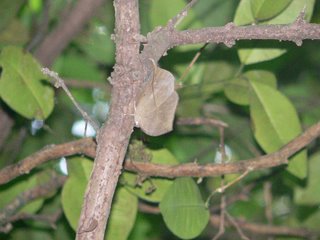
From somewhere the lines of a poem came to my mind, ``The woods are lovely dark and deep……….” as deeper and deeper into the forest we went. And then, as if by magic, the forest ended and we found ourselves on the top of a hill. Actually, there were hills all around dotted with trees. The cool air was like balm to our hot tired selves. At this altitude, we could almost walk among the rolling clouds which looked like wisps of cotton.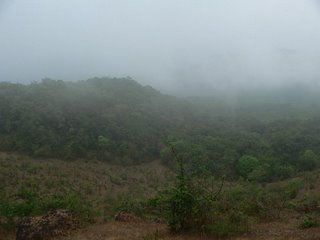
Somebody shrieked excitedly and we could see a Sambar which
bolted away and disappeared on the other side of the steep hill. Atleast the trek had yielded this sighting we thought. Some of us adventurous ones decided to climb to the extreme top of the hill. We were rewarded with a fantastic view for our efforts.
Soon, we headed back, again into the thick, dark forest. This time the climb downhill was easy on our tired limbs though there was the danger of losing our footing.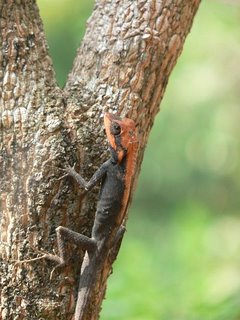 Our vehicle was this time parked on the tarred road and not inside the forest. It was an exhausted but triumphant party that reached the Anshi Camp.
Our vehicle was this time parked on the tarred road and not inside the forest. It was an exhausted but triumphant party that reached the Anshi Camp.
Breakfast was already laid out for us and we gobbled it down. After a quick bath, we packed and bid good-bye to Anshi National Park.
Syntheri RocksOur next stop was the Syntheri Rocks, a few kilometers away. All the way, the forest cover was thick and soon we came to a sign which announced `Syntheri Rocks’. To get

to the spot, we had to climb down a number of steps and then we caught sight of it. Actually rocks was a misnomer. It was more like a massive mountain block which was many meters high with huge crevices where the bees had made their home. On the top end of this mountain mass, there were trees. Interestingly down below, the mountain had branched out into caves. Here, the place was filled with water, perhaps fed by a river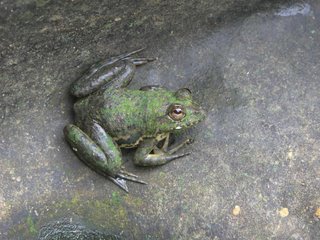

.
A small waterfall was also present. A notice warning people not to swim had been put up. It certainly looked inviting but perhaps was dangerous as hell. We spent a few minutes here and the climb back was very tiresome for the steps were steep. From here, next on our itinerary was Dandeli and as we made our way to Dandeli, we caught sight of hill mynahs, couple of Malabar giant squirrel and forest fowls.
It was almost evening by the time we reached Dandeli and could not do much except that we spent some time by the mighty Kali river. Along the river bank, we spotted few large hornbills which could be seen flying across the river in its own unique style in spurts and gasps. Actually, hornbills are a common sight in Dandeli. Anyway, I was glad to see them for I simply love these birds. Also at Dandeli, somebody in our group identified a person as an African Siddiki tribal.
For dinner, we stopped at Dharwad and shopped for the famous Dharwad Pedha and Kardant. After partaking of dinner at one of the `Khanawalis’, we were off and the next morning saw us safe and sound at Bangalore.
For our group of eight, it had been four days of fun and merriment, adventure and travel, which had come to an end. We had traversed 1800+ kilometers, enriching
ourselves with the wondrous experience. Now, back to the grind it was again. But in my mind, I played back the tapes of Yana, Haldipur, Dhareshwar, Gokarna, Anshi, Dandeli…….
Sunita Raghu.
Karnataka’s famed coastline runs through the districts of Uttara Kannada and Dakshina Kannada. The landscape throughout rarely differs – swaying coconut and areca nut palms, beautiful beaches and the vast expanse of the blue seas, framed by the thick green vegetation of the Western Ghats. And soon you might want to call this place home!
With no definite itinerary but just to take it as it comes, we started our journey from Bangalore at around 10.00 pm. As we woke from our sleep, our eyes soaked up the beautiful sight of what is known as the Jog Falls. This time of the year, there was

not much water, just a thin white line. Nevertheless, we did appreciate the striking topography of the place and one understands why Jog Falls enjoys the reputation of being the highest waterfall in India. Steps, which help people to appreciate the falls from different angles have been put up here. As, Raghu went to explore more, he heard the sound of a small stream nearby from where a whistling sound could be heard. This was at about 7 in the morning. It could, however, not be attributed to a happy, merry person but was the handiwork of the whistling thrush, which remained hidden but for its whistling with variations in pitch and cadence. Also dove calls could be heard. Promptly, he recorded the sounds on his cell phone.
Jog was just meant to be a whistle stop on our way. And soon after a refreshing cup of tea (or coffee as the case may be), we proceeded to Honnavar, a small coastal town in Uttara Kannada.
On the way, we came across a sign post which declared `Sharavathi River Valley’. A platform constructed next to it provided a good view. We could see the river, snaking its way between hills, thick and green with vegetation, The river did not

appear to be flowing briskly but on closer inspection (with binoculars), we could see that it was flowing, albeit slowly. Orioles and small, yellow coloured birds flew merrily all around the place with langurs jumping from one tree to another. Also, large raptors could be seen soaring above the valley. A sumptuous treat for a bird/nature lover.
A good bath to wash away the rigours of an overnight journey and after a good sized breakfast we were off, this time to explore a place called Yana, about 45 kilometers away from Honnavar.
Yana
An exotic sounding name and an equally exotic experience to match. As we came closer and closer to our destination, our vehicle had to navigate through a rather thick forest with very bad roads and steep curves on the way. We enjoyed the beauty of the forest and the lovely trees but not so our driver who muttered colourful curses each time he had to navigate a rather steep curve.
As we kept on going, it looked like as if we had come to the end of the world. Just one or two rickety shops on the way and a few solitary houses. Some of them had a kennel of sorts for the dogs. This was to protect them from the leopards which found them easy prey. Finally, we came to a point where all vehicles had to stop for the journey now would be done on foot. A trek of about one and a half kilometers would take us to the top where the real attraction lay.
And so it began. We trudged along slowly. The path got steeper and steeper. On one side was a thick forest cover and on the other side a little stream gave us company. Although it was very hot in these parts, here it seemed very cool. The place was also rife with dragonflies


and butterflies, adding a dash of colour as they darted around. My husband felt his trip was made when he was able to photograph the monitor lizard

which in appearance looks like a miniature version of the dinosaur. Apparently, the locals here have been able to sight the deadly reptile – King Cobra. All along the way were little waterfalls which cooled anyone who chose to take a dip.
The path was now distinctly uphill and we had to frequently stop on the way to catch our breath. There were steps now and at the last turning there they were – the wonders of Yana.
A huge lofty black structure many meters tall, with jagged edges jutted out into the sky looking arrogant and stately simultaneously. Man might never be able to

replicate this creation. It was a jaw dropping sight to be sure. I almost felt I was in Inca country. Inside this structure, there were hollows where temples could be found.
A second structure which looked very much like the first one awaited us. Similarly striking, there was a temple at the base dedicated to Lord Shiva. The temple priest told us a rather fetching tale about the history of the place. The only bit I was enlightened about was as to how the place got its name. The place was formerly known as `Sahyadripura’. In the times of the British, people who trekked here, when

questioned by their colonial masters said they were going on a `yana’, meaning pilgrimage in Kannada. The British thought that perhaps the name of the place was
 Yana and hence it came to be known as Yana. Trust the British to twist anything to their convenience! A pradakshina around the temple takes one through caves and as you complete encircling the temple, you feel like patting yourself for the accomplishment.
Yana and hence it came to be known as Yana. Trust the British to twist anything to their convenience! A pradakshina around the temple takes one through caves and as you complete encircling the temple, you feel like patting yourself for the accomplishment.Viewed from different angles, the structures present a different look altogether. Scientists and geologists have been at pain to explain how these rock-like formations took place. Some say it was due to a volcanic eruption. Whatever the case might be, the underlying truth is that the twin structures must be the handiwork of a rather playful and teasing God.
As we made our way back, we were able to catch sight of two Malabar grey hornbills. We tried to take a picture but they disappeared into the forest. Thus, having exercised every muscle in our body, we returned to Honnavar, weary with exhaustion, but basking in the glow of achievement.
The next day, we set out to see the beach at Dhareshwar. Dhareshwar was close to Kumta, another small coastal town. From Kumta, as we travelled on the national highway (connects to Udupi, Mangalore and Kerala), a small village called Dhareshwar appeared. Here, just off the main road, was a diversion for about a kilometer or so and this road lead us to the Dhareshwar beach. One would never guess how close the beach was from the highway. It was like our own private paradise. Except for a few local children playing cricket, there was hardly anybody on the beach. Miles and miles of white sand and the blue sea, one side being cordoned off by a big mountain. What beauty, what peace, what tranquility. After that we were off to a little village called Haldipur, about 3 kilometers from Dhareshwar. Be still I told my wildly beating heart as we reached Haldipur for Haldipur happened to be my Dad’s native place. The river (actually backwaters of the sea), the Konkan Railway line which cut right across the village, the coconut/areca nut groves, the quaint houses was all like a walk down memory lane. Ah! How nostalgic one gets.
After a good lunch hosted by relatives, we set out for Gokarna, an hour and a half’s drive from Haldipur.
Gokarna
The sea side town of Gokarna is a big draw with Indians and foreigners alike. For the former, Gokarna represents a holy place with the added allure of a beach and the sea. For the latter, it is the pristine beauty of the beaches.
Roughly an hour’s drive from Haldipur and we were in holy country, Gokarna. We decided to first check out the Om Beach

at Gokarna, which is a few kilometers away from the main shrine. As we drove on the road leading to the beach, we caught a glimpse of the beauty that unfolded before us – the blue sea and the Om Beach,

so called as it resembled the shape of the Hindu mystical symbol `Om’. Sheer genius to bring home this observation and a case of divine providence perhaps, being located in Gokarna – an ancient place of Hindu worship.
Om Beach was all seclusion. It was as if this portion was cut off and put where it currently is. From a good height above, we got to see the entire beach spread out before us. To get to the beach, we needed to navigate a few steep steps. At this point, high up, we were treated to a bird’s eye view of the beach. There were not too many people on the beach. Just about this place, on a tree branch which stood out, were a pair of red vented bulbuls

which we managed to shoot. Just then, a pair of black naped orioles flew past us which we could only gape at.
In recent times, Om Beach has acquired fame as the favourite haunt of foreigners. They were all there, scattered all along the beach in small groups, some eating and drinking in the shanties that had cropped up on the beach.
The waters looked inviting and tentatively at first and gaining confidence with every little drenching, we waded out into the sea. We frolicked about, shrieking, when caught by a rather large wave. What is it about the sea that turns well-mannered adults into shouting, playful, boisterous children? Ah! One needs but to experience it.
After an hour or so in the water, we took a walk along the beach. As we walked, we noticed a few boats carrying people and it looked like they were enjoying a ride on the sea. We decided to try this one out. After the mandatory haggling, the boatman after having seated us in his boat took us for a lovely ride. Far, far away from the beach the boat went into the blue swirling waters of the sea. We noticed an island in the distance and a few people waved to us, which we heartily reciprocated. It was a novel experience, out in the sea on a rather rickety boat with no life jackets! The cool breeze soothed our fevered brow and soon our ride came to an end. Could not sight any sea birds in this vicinity.
After that, we left behind the delights of Om Beach and as we made our way to the main shrine at Gokarna, the sun seemed to bid us good-bye as it began its journey westward. From a big red fireball, it seemed to diminish in size until it was a red dot and it all but disappeared from our view altogether, leaving behind the sky awash with a multitude of colours.
After this ethereal experience (no matter how may times you watch it), our next stop was at the beach which is just a stone’s throw from the main shrine at Gokarna.. The scene that was presented to us here was very unlike the Om Beach. Here, there was a sea of humanity; some on the beach, sitting and chatting and some others playing about in the sea. The entire atmosphere resembled that of a fair what with makeshift shops dotting the beach, hawking their wares from beverages, fried snacks and other sundry items. A few of our party proceeded to gambol about in the sea. Some of us were rather hungry (the air makes it so) and we went to one of the shops and had our fill.
After that it was time for us to pay our respects to the presiding deity of Gokarna, Lord Shiva. Gokarna is an important place for the followers of Shaivism. Mythology tells us that when Ravana could not fulfill his promise of not keeping the linga (which Lord Shiva gave him as a boon) on the ground, thanks to the intervention of a rather mischievous Ganesha, he flung the linga in anger and one piece is supposed to have landed in Gokarna. Hence, the religious importance attached to the place.
By now, it was almost 9 p.m. and the business of eating dinner presented itself. We went to one hotel recommended by most of the town folk but to our disappointment, they had just closed their dinner service. Finally, just a few steps ahead, there was a hotel and thankfully their service was open. There was a rooftop restaurant and we huffed and puffed our way to the top (the stairs were rather steep). The table next to ours was occupied by two foreigners, both young girls. My father-in-law marveled at the freedom their parents gave them to be able to travel to a distant land and that too unescorted.
We had already decided to spend the night in Gokarna. We scouted around for accommodation and as we were doing so a priest volunteered to show us a decent place. It was actually a newly constructed house owned by locals and the rooms on the first floor doubled as a hotel room. Quite an enterprise! So, we spent the night there and the very next morning headed out to the beach near the main shrine. A few meters before the beach, we caught sight of the stork billed kingfisher which then made itself scarce among the coconut palms.
At the beach, a small crowd had already collected there. The waves here were quite rough and huge. A few young men seemed quite at ease, riding the waves. Encountering a rather huge wave, I lost my balance and came up all sputtering with a good deal of sodium chloride in my mouth. After that out of a healthy respect for the sea, I stayed a little distance away, enjoying myself nevertheless. After this, we breakfasted at a popular hotel and then said our byes to Gokarna but not before picking up a few knickknacks. Collecting souvenirs from places that I visit has almost become a ritual with me.
Our next halt was a very brief one at Karwar. The naval base `Seabird’ is located here and we could see a huge ship that was docked there. As it falls under the Defence jurisdiction, no one is allowed admittance. We managed to catch sight of it at a certain bend in the road. We spent a few minutes on the beach named after the Nobel laureate, Rabindranath Tagore. In one of his memoirs, he has described the Karwar beach in glowing terms.
We had enjoyed our bit of the sun, sand and the sea and it was now time to wrap it all up with a new kind of experience where silence is golden, punctuated only by bird/animal calls and insect sounds. Yes, Anshi National Park, situated on the Karwar-Dandeli road was to be our next stop.
Kadra View Point


Anshi National Park
After a quick lunch at Karwar, we were on our way. For nature lovers, a sure treat was in store – lovely trees on both sides of the road and dense at that. The magic never stopped and my eyes took in all this beauty hungrily and thirsting for more. And finally we were in the lap of nature itself as we entered the gates of the Anshi National Park. The park is home to many birds and animals. Elephants are not found here but the park is home to the most beautiful, very shy – black panther.
We refreshed ourselves with a good cup of tea/coffee and then decided to go for a stroll in the forest. Leaving our vehicle at some distance in the forest, we decided to explore on foot. One, two, three, we walked in single file on the narrow forest path and on both sides the forest cover was thick. Quite unlike our experience at other wild life parks. As it was nearing dusk, we looked about warily, holding sticks in our hand should we come across a carnivore or any other animal that the forest was blessed with. Soon, almost by magic, we came to a clearing and here the evening light was still present.
We decided to go back as it would be dark soon and god knows what dangers lurked here! Raghu, my butterfly/dragonfly loving husband, was busy photographing a couple of them. He later identified one of them as the adult ant-lion.

We implored him to hurry up. Then we marched back and the sight of our vehicle was very reassuring.
Back then within the camp and we relaxed in the huge sitting/dining area on rattan chairs. All around it was dark save for this area and the kitchen. Here, solitude gets a new meaning. We decided to explore the area just outside the gate of the park. As we strolled along the tarred road, the moon was missing and hence it was dark which made us feel very eerie. A perfect setting for an Edgar Allan Poe story! The darkness made the forest look sinister. For all we knew, the elusive black Panther could have crossed the road and we would have been none the wiser. Not all the money in the world could have coerced us into venturing into the forest. We did not dally around much but returned back quickly. Soon dinner was served and it was quiet once again with everybody concentrating on their food.
The most noticeable thing about the place was the very trendy, eco-friendly tents that were put up here for our sleeping pleasure. The tents had been erected on a raised platform (so that no unwelcome visitors could gain entry!) and even had a door that could be locked. It almost looked like the home of the three bears which goldilocks had gate crashed into except for the fact that while there were three beds in the fairy tale, here there were two. So, only two people could sleep within one tent. There was a slim tube light within each tent and we were warned that lights would be off at 12.
We were woken up by the chattering of the birds and one particular bird had us spellbound – the whistling thrush. It whistled its way into our hearts and kept us in good cheer. After our morning cup of tea/coffee and accompanied by our forest guide, we prepared ourselves for a trek inside the forest.
Again armed with stout sticks, we started our walk. We kept looking hither and thither but could not see any animal. Perhaps, they were watching us and were keeping themselves hidden. At a certain point, we came across as what is known as the tiger tank where all animals came here to quench their thirst.
 There was hardly any water in the tank except squelchy mud and we noticed some footprints in the mud, proof that some creature had come here. Ssssshhh! Warned our guide and we could with the help of our binoculars see a rather big owl perched on a faraway tree with fierce looking eyes.
There was hardly any water in the tank except squelchy mud and we noticed some footprints in the mud, proof that some creature had come here. Ssssshhh! Warned our guide and we could with the help of our binoculars see a rather big owl perched on a faraway tree with fierce looking eyes. 
The path had now started to get a little steep. We rested at regular intervals. Raghu was fussing over a rather dry leaf. It turned out that it was a butterfly. What camouflage the creatures adopt!

From somewhere the lines of a poem came to my mind, ``The woods are lovely dark and deep……….” as deeper and deeper into the forest we went. And then, as if by magic, the forest ended and we found ourselves on the top of a hill. Actually, there were hills all around dotted with trees. The cool air was like balm to our hot tired selves. At this altitude, we could almost walk among the rolling clouds which looked like wisps of cotton.

Somebody shrieked excitedly and we could see a Sambar which

bolted away and disappeared on the other side of the steep hill. Atleast the trek had yielded this sighting we thought. Some of us adventurous ones decided to climb to the extreme top of the hill. We were rewarded with a fantastic view for our efforts.

Soon, we headed back, again into the thick, dark forest. This time the climb downhill was easy on our tired limbs though there was the danger of losing our footing.
 Our vehicle was this time parked on the tarred road and not inside the forest. It was an exhausted but triumphant party that reached the Anshi Camp.
Our vehicle was this time parked on the tarred road and not inside the forest. It was an exhausted but triumphant party that reached the Anshi Camp.Breakfast was already laid out for us and we gobbled it down. After a quick bath, we packed and bid good-bye to Anshi National Park.
Syntheri RocksOur next stop was the Syntheri Rocks, a few kilometers away. All the way, the forest cover was thick and soon we came to a sign which announced `Syntheri Rocks’. To get


to the spot, we had to climb down a number of steps and then we caught sight of it. Actually rocks was a misnomer. It was more like a massive mountain block which was many meters high with huge crevices where the bees had made their home. On the top end of this mountain mass, there were trees. Interestingly down below, the mountain had branched out into caves. Here, the place was filled with water, perhaps fed by a river


.

A small waterfall was also present. A notice warning people not to swim had been put up. It certainly looked inviting but perhaps was dangerous as hell. We spent a few minutes here and the climb back was very tiresome for the steps were steep. From here, next on our itinerary was Dandeli and as we made our way to Dandeli, we caught sight of hill mynahs, couple of Malabar giant squirrel and forest fowls.
It was almost evening by the time we reached Dandeli and could not do much except that we spent some time by the mighty Kali river. Along the river bank, we spotted few large hornbills which could be seen flying across the river in its own unique style in spurts and gasps. Actually, hornbills are a common sight in Dandeli. Anyway, I was glad to see them for I simply love these birds. Also at Dandeli, somebody in our group identified a person as an African Siddiki tribal.
For dinner, we stopped at Dharwad and shopped for the famous Dharwad Pedha and Kardant. After partaking of dinner at one of the `Khanawalis’, we were off and the next morning saw us safe and sound at Bangalore.
For our group of eight, it had been four days of fun and merriment, adventure and travel, which had come to an end. We had traversed 1800+ kilometers, enriching

ourselves with the wondrous experience. Now, back to the grind it was again. But in my mind, I played back the tapes of Yana, Haldipur, Dhareshwar, Gokarna, Anshi, Dandeli…….
Sunita Raghu.

3 Comments:
At 2:02 PM, May 24, 2006 , s c r a p s s t u f f s said...
s c r a p s s t u f f s said...
Nice! We aim to do this trip sometime after the rains but plan to go up from Mangalore until Karwar and then come back to Bangalore via Dharwad. Your blog will come in handy for places to visit.
At 10:22 AM, May 30, 2006 , Anonymous said...
Anonymous said...
A very well written story of an astounding journey that takes the reader along to explore the wonders of nature with great attention to detail, complimented by some unique moments frozen as images. Sitting at home, I enjoyed this "virtual journey" along with the keen minds of this wonderful couple Raghu and Sunita. May your breed increase :-) .. regards, Vijay Cavale
At 8:49 PM, March 21, 2008 , Shyam said...
Shyam said...
That was nice. Made me recollect my own trip to Yana last year for new year. We had erected tents on the Gokarna beach and trekked along the beaches. Lovely place. Hope the resort encroachments dont continue.
Post a Comment
Subscribe to Post Comments [Atom]
<< Home